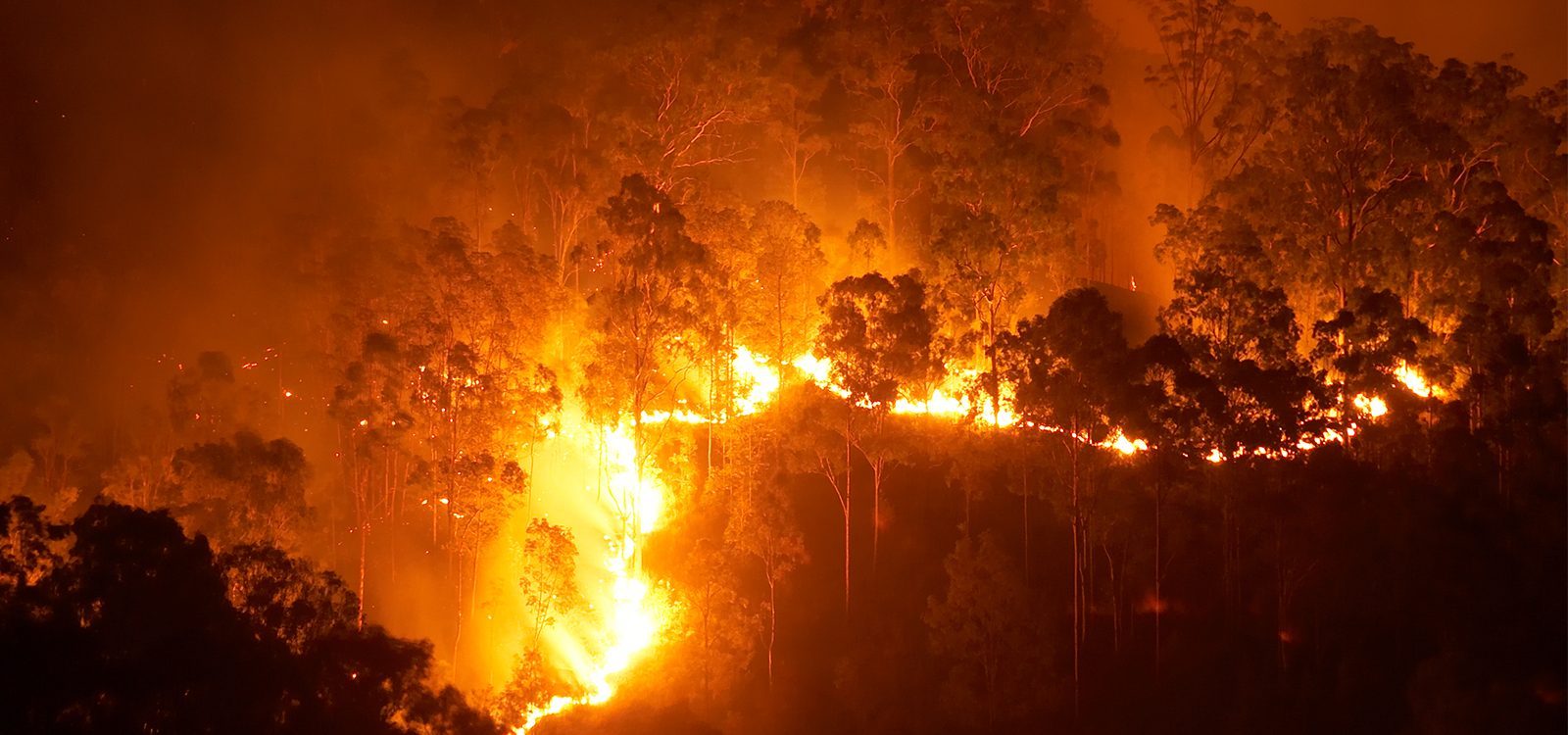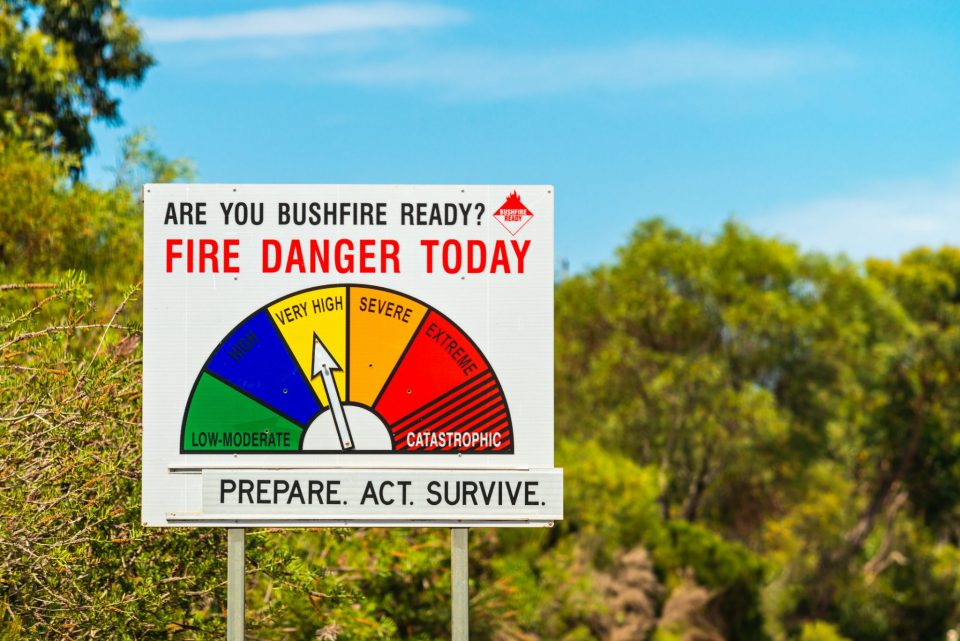
Insuring the inferno: addressing bushfire risk in a changing climate
As bushfire rages in Eastern Australia, this article considers how mitigation and insurance can play a role in closing an emerging ‘protection gap’.
As the current drought continues to grip large sections of East Australia, and with the austral summer still to come, this bushfire season has already been labelled as ‘unprecedented’. Although natural climate variability is a major factor explaining the severity of the current fires, and while a single season cannot be exclusively attributed to climate change, the warming and drying trends observed in large swathes of South East Australia have indeed created ripe conditions for more intense and widespread bushfires.
While there may be an element of reporting bias in recent years as more homes are built closer to the wildland urban interface, bush fires have been around for millennia, and are sometimes necessary to sustain ecosystem health. Recent large events around the world such as the South East Asian Haze Outbreak (2015), Fort McMurray (2016) and Camp Fires (2018) have captivated international interest.
Over the past few decades however, there is convincing scientific evidence that bushfire seasons are getting longer, and inter-event time between significant events is reducing (from one in seven years in previous decades to one in three years today in South East Australia[1]) – further hampering fire fighters operating on stretched resources.
In fact, our fire fighters sent to assist California during the northern hemispheric summer actually had to be suddenly recalled to attend to unseasonal fires in our own backyard during the austral winter of 2018.

Ominously, climate models are predicting more extreme climate variability in the future- with studies anticipating a doubling in the frequency of extreme El Niños, which are associated with dry conditions in East Australia[2].
Against this backdrop, this article explores the impact of bushfires on economic losses, and how mitigation and insurance can play a role in closing this emerging protection gap.
Bushfire losses to date – tip of the iceberg
Consistent with underlying hazard trends, it comes as no surprise that economic losses from forest fires around the world have also been increasing. In fact, fires have been emanating from areas traditionally not known to produce extreme fires such as boreal forests of Artic and parts of Canada, and beyond the typical burning seasons. Background climate trend aside, land use change and human encroachment into forest frontiers are also contributing factors.
Wild fire driven losses worldwide have increased so dramatically that they are no longer considered ‘attritional’ or ‘secondary’ to the insurance industry. Strikingly, total insured losses from wild fires was under USD 10bn for 1990s and 2000s but have exceeded USD 45bn this decade[3]. To illustrate, the ranks alongside Hurricane Michael and Typhoon Jebi as the industry’s leading loss driving events for 2018.
Yet, insured losses to date have been dominated by agriculture, property damage and associated business interruption.
While significant, it masks myriad hidden externalities which contribute to true economic loss. For example, current estimates do not consider biodiversity loss, particularly in the rainforests of South East Asia and the Amazon, nor costs to public health, tourism and transport sectors from transboundary smoke haze that is transmitted to distant areas far from burning source sites. In fact, the 2015 Indonesian peat forest fire outbreak was so severe that neighbouring Singaporeans indicated willingness to pay a ‘tax’ of sorts for clean air guarantee to prevent repeat incidents in the future.
As peril intensity increases, other plausible avenues of economic loss may include increasing costs of fire suppression, or – through the creation of a negative feedback loop by further exacerbating climate change via sudden bursts of unplanned carbon release – thwarting the commitments of Paris COP signatories.
Coverage gaps, challenges and potential solutions
From an insurance standpoint, the provision of reliable and adequate capacity for wildfires has been called into question of late. There are several factors that contribute to this issue, ranging from pricing challenges due to the inherent complexity of the physical dynamics of fire propagation (further complicated by a strong climate trend), poor recent loss experience particularly from the liability side, and well-meaning government subsidies that create both an undercharging situation where premiums are incommensurate with risk, as well as moral hazard where builders and homeowners are not incentivised to implement effective risk management.
On the other hand, where insurance is made available, affordability issues may arise[4]. This is often the result of poor planning decisions or enforcement of building codes, meaning that homes and businesses located in wildland urban interface are built in areas which attract too high a premium to be sustainable.
While longer term policy decisions need to be made to address broader planning and affordability issues, the insurance industry can play a key role through the creation of new avenues to enable virtuous and sustainable risk transfer solutions.
For example, instead of focusing exclusively on indemnifying devastated homes, parametric insurance solutions[1] based on satellite imagery of the extent of fires could be used to boost fire-fighting resources to prevent fires from getting beyond control. As there will inevitably be losses to infrastructure and homes despite fire-fighting efforts, insuring this residual risk could also involve dispensing liquidity not to restore former homes situated in high risk zones, but to assist with resettlement and rebuild efforts in safer areas given that wildfire damage is binary and often entails complete destruction of the impacted asset.
To ensure alignment with government and/or local councils – perhaps these insurance schemes could be administered in the form of a risk pool with government subsidies where appropriate. This would help identify high risk areas and compel government to take pro-active mitigation measures to reduce risk and reduce subsidies in the process. Furthermore, if these risk pools grow to sufficient scale – there is also the possibility of tapping into international financial markets.

As discussed earlier, another emerging risk from extreme bushfires revolves around economic losses due to ensuing smoke haze and air pollution – often in areas remote from the burning sites. Traditional insurance policies are ineffective in this regard as business interruption loss requirements are premised upon property damage. To this end, novel parametric solutions can also be creatively utilised to leverage increasing availability and transparency of technology and data. In fact, there is already such a product in the local Singapore market[6] which is triggered by elevated Pollutant Standards Index (PSI) concentrations reported to the general public by the National Environment Agency (NEA) to insure against non-damage business interruption losses due to smoke haze events emanating from neighbouring Indonesia.
Concluding, while the threat of wildfire risk is rapidly evolving and continues to be fuelled by climate change, it is imperative that the insurance sector leverages its keen expertise in underwriting complex risk. It must also demonstrate market driven leadership by sending the right pricing signals and seeking innovative ways to underwrite bushfire risk. This would help support the right societal attitudes to the threat of forest fires and incentivise broad based action in mitigating against catastrophic events in the future.
This article represents the views of the author and does not necessarily reflect those of the Actuaries Institute.
[1] Sharples et al., Natural Hazards in Australia: extreme bushfire, Climate Change, 2016
[2] Cai et al., Increasing Frequency of extreme El Nino events due to Greenhouse Warming, Nature Climate Change, 2014.
[3] Source: The Burning Issue: Managing Wildfire Risk, Marsh Mclennan Companies Insights, 2019
[4] https://theconversation.com/in-fire-prone-california-many-residents-cant-afford-wildfire-insurance-119451
[5] Rather than indemnity, parametric solutions pay out based on the ‘triggering’ of pre-defined thresholds of an index that acts as a good proxy for loss intensity. While there is basis risk attached to these solutions, it can be mitigated through sound structuring principles and the benefits of an innovative payout to address bushfire risk outweighs basis risk.
[6] See: https://corporatesolutions.swissre.com/innovative-risk-solutions/non-physical-damage-business-interruption/hazeshield.html
CPD: Actuaries Institute Members can claim two CPD points for every hour of reading articles on Actuaries Digital.






